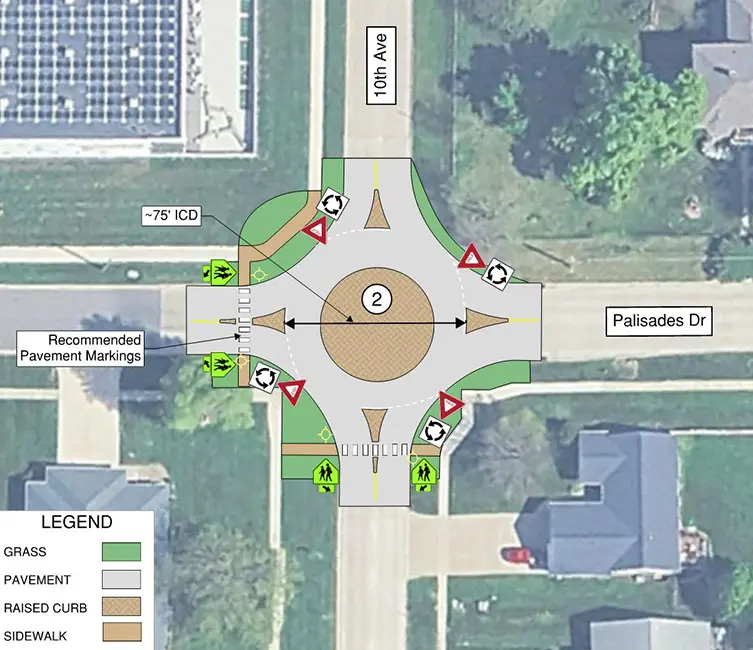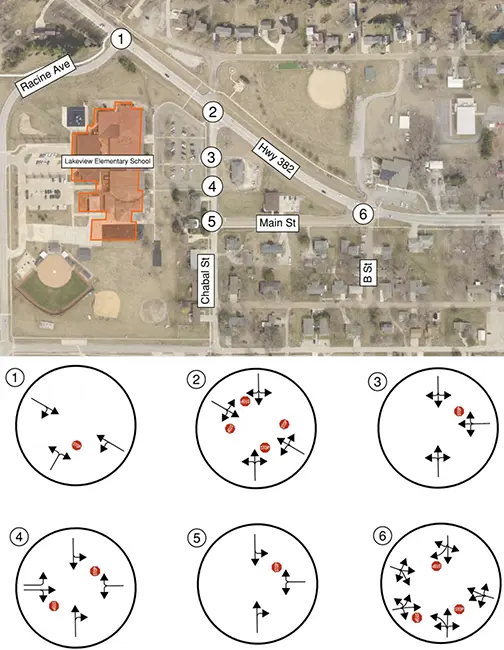When a community faces traffic safety concerns like a congested school pick-up zone, a confusing intersection, or unsafe pedestrian crossings the solutions can be complex. But many cities and counties don’t have the budget or in-house staff to tackle those problems alone.
That’s where a TEAP Study comes in.
We spoke with Jack Gepson, a traffic design professional, Shive-Hattery, to unpack what TEAP Studies are, how the process works, and how they can help communities across Iowa.
For Jack, traffic engineering is about maximizing community impact.
“I grew up in a small town, and I love the idea that these studies directly improve daily life in communities like the one I came from. It’s not just about data, it’s about making things safer and more functional for the people who live there.”

A mini roundabout is proposed to reduce congestion and improve traffic flow during peak school drop-off and pick-up periods. This design minimizes stop-and-go conditions, enhances operational efficiency, and increases safety by reducing conflict points — all within the existing roadway geometry.
What is a TEAP Study?
TEAP stands for the Traffic Engineering Assistance Program, administered by the Iowa Department of Transportation (DOT). The program provides up to 150 hours of free traffic engineering expertise to cities and counties that don’t have a traffic engineer on staff.
Jack explains:
“The program is designed to help communities without the resources to conduct their own studies. We work alongside local governments to evaluate problems—whether it’s a high-crash intersection, traffic delays, pedestrian safety, or even reviewing roundabout plans—and then develop actionable solutions.”
Communities in Iowa under about 35,000 residents, as well as all counties, are typically eligible.

What Issues Can TEAP Studies Address?
TEAP studies cover a wide range of traffic and safety challenges, including:
- Safe Routes to School – ensuring kids can walk and bike safely.
- Bicycle Routes – evaluating corridors for connectivity and safety.
- Pedestrian Crossings – making crosswalks safer near libraries, schools, and community facilities.
- School Traffic Circulation – tackling congestion at drop-off and pick-up zones.
- Complicated Intersections – simplifying confusing layouts or crash-prone areas.
- Miscellaneous Traffic & Safety Studies – tailored to a community’s unique needs.
- TEAP study will deliver unbiased, practical recommendations and provide a clear path to funding and implementation.
Download
TEAP at a Glance
For communities that want a quick overview of how the program works, we’ve created a TEAP Information Sheet that summarizes:
- Program eligibility and requirements
- Typical study subjects and funding details
- Step-by-step application process
- Vulnerable road user safety component
- Contact information to get started with support from Shive-Hattery
How does the process work?
- A city or county submits a short letter describing the problem. Shive-Hattery often helps draft this request.
- District and central DOT offices review and approve the request.
- If approved, the DOT assigns the study to one of its consultants. Communities may request Shive-Hattery specifically.
- Stakeholders meet with Shive-Hattery and the DOT to discuss the issue in detail.
- Traffic counts, safety reviews, and site observations as needed.
- Shive-Hattery develops multiple solutions with cost estimates and phased options (short- and long-term improvements).
- Reports are shared with the DOT and tailored into presentations for city staff or councils so findings are clear, accessible, and actionable.
Proposed strategies at key intersections include geometric realignment to simplify traffic patterns, selective leg closures to enhance safety and reduce confusion, and installation of a mini roundabout to improve traffic flow during peak periods. Collectively, these improvements aim to reduce congestion, improve pedestrian visibility and mobility, and create opportunities for green space and future connectivity enhancements.
What are the benefits of conducting a TEAP Study?
Communities that complete a TEAP Study gain more than just a technical report—they get a roadmap for action:
- Funding Advantage: TEAP reports strengthen applications for state and federal safety grants.
- Phased Improvements: Recommendations come with cost estimates and short-, mid-, and long-term strategies, helping cities budget realistically.
- Clear Grant Pathways: Each recommendation identifies which specific funding and grant opportunities may apply, providing cities clarity on where to focus their efforts (and where not to waste time).
- Community Buy-In: Findings can be shared with councils and residents in ways that build support for change.
- No Cost to Communities: The program is entirely free for cities and counties. Shive-Hattery also helps prepare request letters at no cost.
“Cities find real value in understanding not just what improvements are needed, but how to fund them,” Jack explains. “That clarity can be the difference between a good idea and a project that actually gets built.”
How can a traffic engineer help?
Shive-Hattery is one of two consultants selected by the Iowa DOT to deliver TEAP Studies statewide. We currently have multiple studies in progress across Iowa.
“We use design charrettes that bring in engineers from across disciplines to brainstorm solutions together,” Jack shares. “That diversity of expertise often sparks ideas that communities hadn’t considered before.”

Jack’s Advice for Communities
Don’t wait. Submitting an application is quick, and the worst outcome is a simple “no.”
Partner early. Talking with Shive-Hattery before applying helps tailor your request to meet program requirements.
Focus on current issues. TEAP is designed for real, existing problems—not long-term planning studies.
Stay in Touch for Monthly Shive-Hattery Industry Insights



